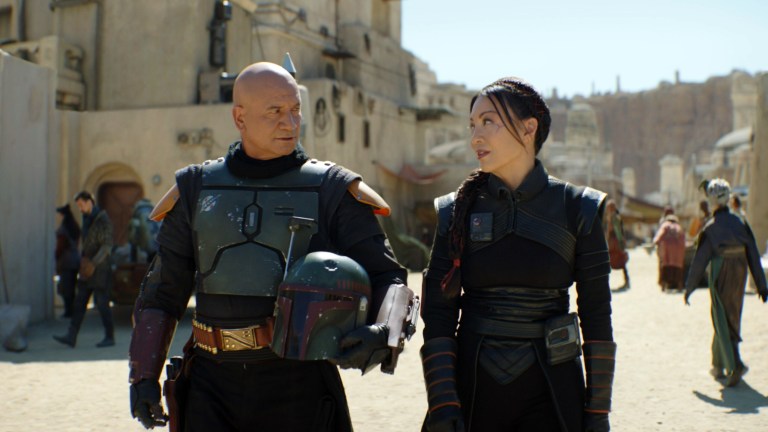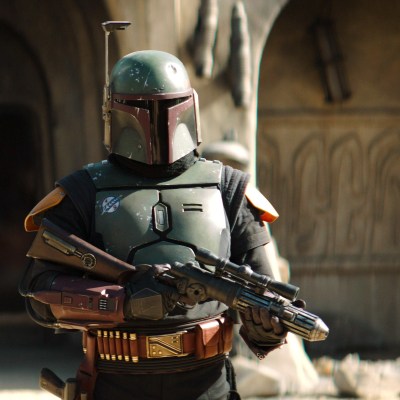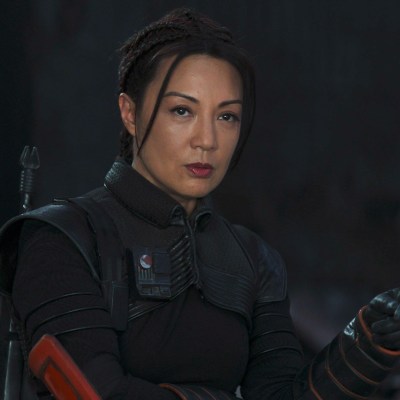Star Wars: The Book of Boba Fett Episode 7 Review: In the Name of Honor
The Book of Boba Fett ends with some ambiguous, anti-climactic character beats.

This Star Wars: The Book of Boba Fett review contains spoilers.
The Book of Boba Fett Episode 7
The Book of Boba Fett remains an oddity. Not essential viewing on its own, the show sets up the future of The Mandalorian without ever really taking its own protagonists in an interesting direction. Star Wars, always full of potential as much as actual ideas, goes purely for the expected here. Boba proves his mettle as a hero of Mos Espa, but the episode sacrifices characterization for a disorganized, toothless plot.
The drug war is ready to break out in full in “In the Name of Honor.” Boba and Din Djarin prepare to make their last stand in Garsa Fwip’s ruined sanctuary, menaced by Cad Bane and the Pykes, while Fennec heads to Pyke headquarters in nearby Mos Eisley. (That’s the town nearest to Luke Skywalker’s former home, a fact this episode blessedly avoids blatantly pointing out.) Boba and Din take a final stand against the Pykes, aided by the Freetowners and their tank.
But more importantly — because threads from The Mandalorian continue to outshine The Book of Boba Fett at every turn — Grogu has made his choice: to return to Din. Luke Skywalker sends him in the X-wing to Peli.
When the Pykes send in two giant walker droids with shields, Boba retaliates with the rancor. Din and Grogu unite in time to take down one of the droids, as well as the rampaging rancor after it shreds the second droid. Boba and Cad Bane clash, with Bane revealing that the Pykes sent the speeder gang that killed the Tuskens. Boba leaves Cad for dead with a literal and symbolic gaffi stick wound in his chest. In the end, Boba’s team wins the day on all fronts, and the denizens of Mos Espa treat him (and Fennec, to a lesser extent) as heroes. Oh, and Cobb Vanth lives!
The star of this episode is the rancor, which looks good enough in some key moments to make up for the floaty action and occasional conspicuous CGI. The best moments propel the creature off the ground, giving the action a clear sense of weight, the rancor swinging around rooftops and towers like a kaiju. The rancor and the killer droid walkers going toe-to-toe is fun, with a kinetic weight and that classic Star Wars triumph of nature over technology.
The humans don’t fare quite as well. Din Djarin’s body language acting continues to be a standout: even his jumps and dodges conveying the marriage between his hapless but nigh indestructible fighting style and his hapless but nigh indestructible good heart. Unfortunately, the reunion between Din and Grogu takes the wind out of the sails of The Mandalorian season 3 more than anything else. It’s too rushed to have enough pathos, even Pedro Pascal unable to soften his voice enough to make “I didn’t know when I’d see you again” sound natural. What could have been the big emotional hook for The Mandalorian season 3 is rushed by with an almost slapstick insertion into a different show entirely. There’s an attempt made to give this moment the space it needs within a hectic chase sequence, but ultimately it moves too fast and takes place in the wrong story.
As for Grogu himself, his part is wisely restrained. While he does have big hero moments, none of them feel too over-the-top because they’re touched with the smallness and gentleness of the little guy himself. Grogu taking a nap next to the rancor he just lulled to sleep with the Force may have more to say about attachment and mercy than a year’s worth of Disney’s recent takes on the Skywalkers.
Even Temuera Morrison, always gamely adding some humor and humanity to his stiff dialogue, seems to have run out of steam for it. The show has certainly shown Boba making choices, such as his rescue of Fennec and the Mods. But his biggest decisions in this episode are undercut. The back-and-forth between Fennec and Boba in front of Cad Bane finally injects some heat into their disagreements, but Cad simply walking away at the end removes momentum.
The speech referenced in the episode title suggests a moment of commonality between Boba and Din. At the same time, Boba’s Tusken-inspired respect for Din’s code makes what exactly Boba believes in and why more watery, not less. Boba doesn’t believe in Mandalorian creed, but he doesn’t exactly believe in Cad Bane’s more selfish code either. Who is Boba Fett then? Whoever is most convenient for that week’s episode?
The reveal that the Pykes were behind the deaths of the Tuskens feels like it should be more of a revelation than it actually is. It turns out the Tuskens really were in the story to hold a mirror up to Boba, turning him into the kinder, gentler version and then falling by the wayside to provide a last-minute emotional punch that doesn’t really land.
I was pleasantly surprised by the conversation between Boba and Cad. It summarizes their relationship in The Clone Wars well enough: Boba was a child when he last saw Bane, and Bane still sees himself as an older mentor dispensing cruel workplace advice. It’s referential without being simply a speech explaining a character’s history. But it also leaves Boba’s moral stakes on a weirdly ambiguous end note. Is Boba really like his father for killing Bane? Presumably not, since Boba reaps the rewards of a good guy, but the real problem is the question isn’t all that interesting.
Meanwhile, the battles in the streets of Mos Espa are low-key and cartoonish. I don’t actually mind the bloodless violence at all: Star Wars‘ kid-friendly action is part of its appeal. But the lack of music stings really show, and the Mods’ tactics feel artificial. A few moments of human connection between Fennec and Drash or Drash and Jo, the spokesperson for the Freetown gang, feel like last-minute edits to hint at relationship arcs that don’t actually exist. Otherwise, the action is static, oddly rooted to locations that lack drama in terms of either emotion or appearance. Drash grew up near one battle site, but her practical delivery of that information makes the place feel more like a set, not less.
“In the Name of Honor” was, at best, a decent adventure story. It restrained the urge to pack in cameos and connections that made the previous episodes feel so disjointed. It’s easy to see why some fans see the two Din-focused episodes as wasting valuable time that could have been used to flesh the two leads out. Fennec still feels more like an action figure or a cartoon angel on Boba’s shoulder than a person. With her character so tied to Boba’s, I wonder whether this might have been Ming-Na Wen’s chance to really shine in Star Wars come and gone.
This kinder Boba never really solidified as a character either. Maybe a more ruthless take on him would have at least lent the show more focus.


